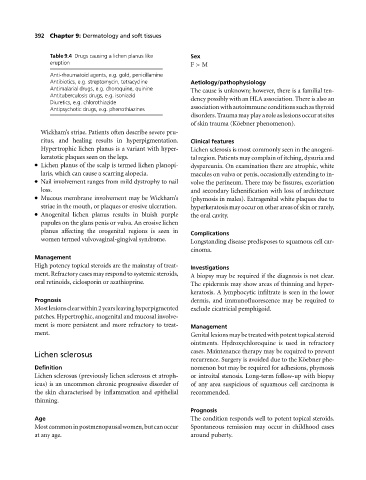Page 396 - Medicine and Surgery
P. 396
P1: FAW
BLUK007-09 BLUK007-Kendall May 12, 2005 19:59 Char Count= 0
392 Chapter 9: Dermatology and soft tissues
Table 9.4 Drugs causing a lichen planus like Sex
eruption F > M
Anti-rheumatoid agents, e.g. gold, penicillamine
Antibiotics, e.g. streptomycin, tetracycline Aetiology/pathophysiology
Antimalarial drugs, e.g. choroquine, quinine The cause is unknown; however, there is a familial ten-
Antituberculosis drugs, e.g. isoniazid dency possibly with an HLA association. There is also an
Diuretics, e.g. chlorothiazide
Antipsychotic drugs, e.g. phenothiazines associationwithautoimmuneconditionssuchasthyroid
disorders. Trauma may play a role as lesions occur at sites
of skin trauma (K¨ oebner phenomenon).
Wickham’s striae. Patients often describe severe pru-
ritus, and healing results in hyperpigmentation. Clinical features
Hypertrophic lichen planus is a variant with hyper- Lichen sclerosis is most commonly seen in the anogeni-
keratotic plaques seen on the legs. tal region. Patients may complain of itching, dysuria and
Lichen planus of the scalp is termed lichen planopi- dyspareunia. On examination there are atrophic, white
laris, which can cause a scarring alopecia. macules on vulva or penis, occasionally extending to in-
Nail involvement ranges from mild dystrophy to nail volve the perineum. There may be fissures, excoriation
loss. and secondary lichenification with loss of architecture
Mucous membrane involvement may be Wickham’s (phymosis in males). Extragenital white plaques due to
striae in the mouth, or plaques or erosive ulceration. hyperkeratosis may occur on other areas of skin or rarely,
Anogenital lichen planus results in bluish purple the oral cavity.
papules on the glans penis or vulva. An erosive lichen
planus affecting the orogenital regions is seen in
Complications
women termed vulvovaginal-gingival syndrome.
Longstanding disease predisposes to squamous cell car-
cinoma.
Management
High potency topical steroids are the mainstay of treat- Investigations
ment. Refractory cases may respond to systemic steroids, Abiopsy may be required if the diagnosis is not clear.
oral retinoids, ciclosporin or azathioprine. The epidermis may show areas of thinning and hyper-
keratosis. A lymphocytic infiltrate is seen in the lower
Prognosis dermis, and immunofluorescence may be required to
Mostlesionsclearwithin2yearsleavinghyperpigmented exclude cicatricial pemphigoid.
patches. Hypertrophic, anogenital and mucosal involve-
ment is more persistent and more refractory to treat- Management
ment. Genitallesionsmay be treated withpotenttopical steroid
ointments. Hydroxychloroquine is used in refractory
cases. Maintenance therapy may be required to prevent
Lichen sclerosus
recurrence. Surgery is avoided due to the K¨ oebner phe-
Definition nomenon but may be required for adhesions, phymosis
Lichen sclerosus (previously lichen sclerosus et atroph- or introital stenosis. Long-term follow-up with biopsy
icus) is an uncommon chronic progressive disorder of of any area suspicious of squamous cell carcinoma is
the skin characterised by inflammation and epithelial recommended.
thinning.
Prognosis
Age The condition responds well to potent topical steroids.
Mostcommoninpostmenopausalwomen,butcanoccur Spontaneous remission may occur in childhood cases
at any age. around puberty.

